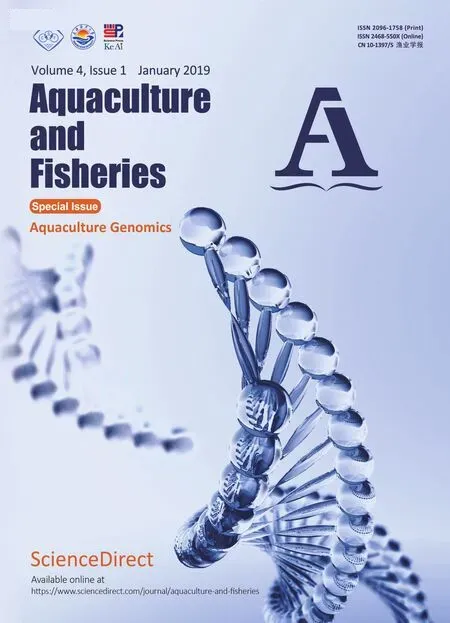Editorial:Aquaculture genomics
What can genomics offer to aquaculture and fisheries?The definition of Genomics,retrieval of biological meaning from large sets of DNA and/or RNA sequences present in organisms,highlights the potential benefits that can be accrued from this burgeoning field.The continuous advances in sequencing technologies and bioinformatic tools,in particular in the last decade,enabled the harnessing of large amounts of genome-wide data from nonmodel organisms which can be used to address both fundamental and applied questions of fisheries,aquaculture and ecology(Abdelrahman et al.,2017).Genomics informed management is now considered absolutely essential if aquaculture and fisheries are to achieve their promise of making a significant contribution to sustainable food security,as the world demand for high quality protein continues to increase(Abdelrahman et al.,2017;Bernatchez et al.,2017;Yanez,Newman,&Houston,2015).However,although genomics approaches have become more common their practical use to improve fisheries management and aquaculture production still has not ful filled its promise,despite overwhelming evidence of its advantages and benefits(Bernatchez et al.,2017;Garner et al.,2016;B.;Louro,Power,&Canario,2014).Among the possible solutions to stimulate wider application of genomics knowledge are the need for greater communication among fishery scientists,geneticists,fishery managers,and also better communication of the potential of genomics approaches and the results to stakeholders by adoption of a clear and understandable dialogue(Bernatchez et al.,2017).While this is still a stumbling block that needs to be addressed in multiple contexts,it is equally important that more genomics-based papers are published in journals of a multidisciplinary nature such as Aquaculture and Fisheries.This special issue is a small but a significant step towards communicating the power of genomics to a wide potential user community.
In the article by Dong,Han,Fang,Xiao,and Wang(2018)they highlight the power of genome wide associations using single nucleotide polymorphic markers(SNP)to uncover quantitative trait loci(QTL)for body shape of the large yellow croaker(Larimichthys crocea).Body shape is apparently controlled by multiple genes located in 4 QTL regions.The markers identified can now be used to select for body shape in breeding programmes for aquaculture,a trait that is the object of consumer preference in China.
Using the same species,Xiao,Cao,Xiao,Wang,and Cai(2018)describe the use of transcriptomics to identify transcripts specific to the testis(897)and ovary(13)and then discuss their possible role in sexrelated events.
Louro et al.(2018)using a different transcriptomics approach,analyse the differential expression of genes in the brain,liver and muscle of fast and slow growing of European sea bass(Dicentrarchus labrax)originated from a common population.This study provides new insights into the molecular basis of growth variation in the European sea bass but is probably also relevant for other species.The results suggest that changes in endocrine regulatory pathways involving the insulin-like growth factor,insulin and the stress axis may be at the basis of the divergent growth.
Ventura et al.(2018)also used transcriptomics to analyse the capacity the regenerative capacity of the retina of the ed-claw cray fish(Cherax quadricarinatus)compound eye.By comparing regenerating and non-regenerating eyes,the authors identified differentially and uniquely transcribed genes of the retina and suggest mechanisms that may regulate ocular regeneration of the crustacean compound eye.
Finally,Batista,Churcher,Manchado,Leitão,and Power(2018)also used transcriptomics to uncover the immunological repertoire of the carpet-shell clam(Ruditapes decussatus).The most represented immune related gene families were C1q domain-containing proteins(63),tumor necrosis factors(15)and toll-like receptors(10).Further phylogenetic analysis revealed a large diversity and lineage restricted-expansions of toll-like receptors.
The studies published in this special issue illustrate how genomics approaches can contribute positively to aquaculture of invertebrates and fish and join the growing body of published articles dedicated to genomics applications in aquaculture, fisheries and conservation(Baltazar-Soares,Hinrichsen,&Eizaguirre,2018;Garner et al.,2016;Waters et al.,2016).We hope that this special issue can be an incentive for wider use of this set of powerful approaches to uncover biological information.
Adelino V.M.Canário∗,
CCMAR-CIMAR,Centre of Marine Sciences,University of Algarve,Campus de Gambelas,Faro 8005-139,Portugal International Research Centre for Marine Biosciences,Ministry of Science and Technology,Shanghai Ocean University,Shanghai 201306,China Key Laboratory of Exploration and Utilization of Aquatic Genetic Resources,Ministry of Education,Shanghai Ocean University,Shanghai 201306,China
National Demonstration Center for Experimental Fisheries Science Education,Shanghai Ocean University,Shanghai 201306,China
E-mail address:acanario@ualg.pt.
 Aquaculture and Fisheries2019年1期
Aquaculture and Fisheries2019年1期
- Aquaculture and Fisheries的其它文章
- Genome-wide association study identifies loci for body shape in the large yellow croaker(Larimichthys crocea)
- Sex-biased gene discovery from the gonadal transcriptomes of the large yellow croaker(Larimichthys crocea)
- SuperSAGE digital expression analysis of differential growth rate in a European sea bass population
- Molecular aspects of eye development and regeneration in the Australian redclaw cray fish,Cherax quadricarinatus
- Uncovering the immunological repertoire of the carpet shell clam Ruditapes decussatus through a transcriptomic-based approach
